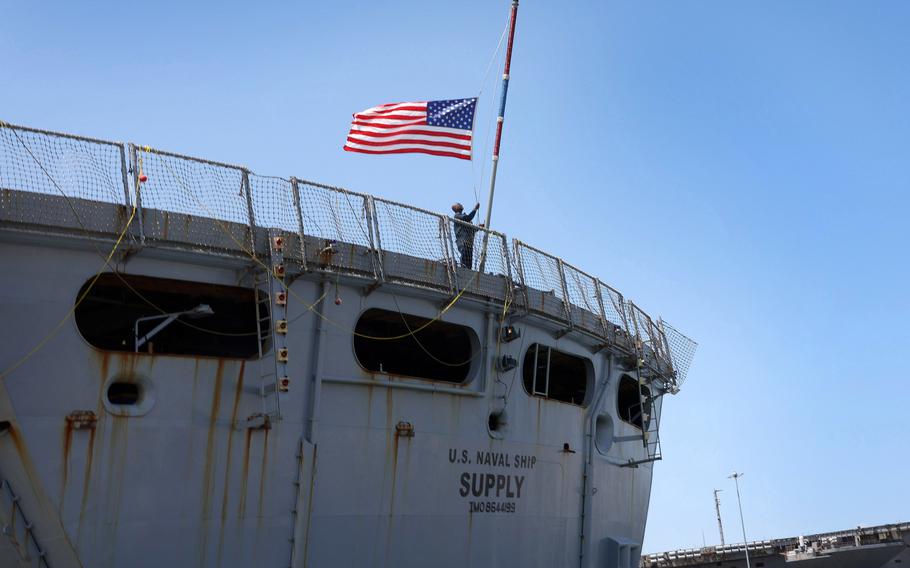
A mariner aboard the fast combat support ship USNS Supply raises the national ensign as the ship moors in Naval Station Norfolk, Va., July 27, 2024, following an eight-month deployment in support of the USS Dwight D. Eisenhower Carrier Strike Group. The Navy is looking for ways to address a critical shortage of qualified civilian mariners without sidelining 17 of its logistics ships. (Hendrick Dickson/USN Military Sealift Command)
NAPLES, Italy — The Navy is considering improved pay and working conditions for civilian mariners among the fixes it hopes will address the manpower shortage crippling its logistics fleet.
The more holistic approach would use Navy-wide resources to address the lack of qualified civilian mariners working for the Military Sealift Command instead of sidelining ships to ease crewing demands.
“We’re looking at (the issue) comprehensively, considering the full scope of challenges and thus looking at all the tools that can be employed to address it,” a Navy official told Stars and Stripes on Monday. The official spoke on condition of anonymity because they weren’t authorized to discuss the issue publicly by name.
Besides potentially offering wages and benefits more competitive with those in the private sector, and ensuring mariners at sea accrue adequate time off, the Navy also wants to step up recruitment efforts, the official said.
That could include working directly with the U.S. Merchant Marine Academy and six maritime academies nationwide to recruit mariners for Military Sealift. Officials also are evaluating ways to add more civilians nationwide and military members who are leaving the services, the official said.
Military Sealift operates about 125 civilian-crewed ships responsible for a range of tasks, such as replenishing Navy ships, pre-positioning combat cargo at sea and conducting specialized missions. But the command is having trouble attracting and keeping workers.
About 5,500 civilians fill about 4,500 billets across Military Sealift. But about 10,000 mariners are needed, experts say.
The grueling schedule has taken a toll on civilian mariners, many of whom have opted to leave the service, Sal Mercogliano, an adjunct professor at the U.S. Merchant Marine Academy who has served ashore and at sea for Military Sealift Command, said in an August post to his X account.
“This has resulted in @MSCSealift churning through personnel,” Mercogliano said.
Experts have likened the shortage of merchant mariners to a national disaster threatening America’s ability to maintain sea power. The issue affects not only the military but also commercial shipping.
To help correct the problem, Military Sealift recently proposed putting 17 ships — two replenishment vessels, an oiler, two expeditionary sea bases and 12 expeditionary fast transports — into an extended maintenance period for a yet-to-be defined amount of time.
The move would free up 700 people to work on other ships, filling gaps and allowing fellow mariners to take more leave.
Several Navy departments and the service’s top officer, Adm. Lisa Franchetti, have reviewed the Military Sealift proposal, now under consideration by Secretary of the Navy Carlos Del Toro.
It isn’t clear precisely what would be included in the evolving plan or if some Navy ships still would face an indefinite hiatus. It’s also unknown when the final plan would be ready.
“The Navy’s review of its options (has been) very deliberate,” the official said. “We understand that the health of the Military Sealift Command … is critical to enabling U.S naval forces to be where it matters, when it matters.”